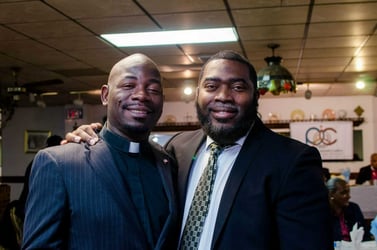
Across the U.S., church attendance statistics paint a concerning picture: church membership decline continues, with fewer Americans attending weekly religious services. But is this trend irreversible? Examining church attendance by generation, we see younger groups like Gen Z redefining spiritual engagement. Meanwhile, studies from Pew Research Center and Gallup show that while some churches struggle, others are thriving. By analyzing key details like church congregation size and participation drop, churches can create strategies to reconnect with their communities. In this comprehensive guide, we'll not only cover the latest data and trends but provide tools and actionable strategies to beat the statistics.
Table of Contents
- How Has Church Attendance in the U.S. Changed Over the Past Decade?
- What Factors Are Contributing to the Decline in Church Attendance?
- How Are Different Denominations Faring in Terms of Attendance?
- What Constitutes "Regular Attendance" in Today's Church Landscape?
- How Are Millennials and Gen Z Shaping Church Attendance Patterns?
- What Do Recent Surveys Reveal About Religious Affiliation and Church Membership?
- How Do Economic and social Factors Influence Church Attendance?
- How Can Church Leaders Interpret These Statistics with Hope for the Future?
- What’s the Path Forward for Churches?
- 7 Free Tools and Resources Churches Can Use to Encourage People to Attend Religious Services
Too Busy to Read? Listen to the Key Takeaways
Get the key takeaways by clicking to listen the podcast summary now!
How Has Church Attendance in the U.S. Changed Over the Past Decade?

Church attendance across the U.S. has dramatically shifted in several decades. Over the past 50 years, the percentage of Americans attending church regularly has steadily decreased. According to Gallup (2021), fewer than half of U.S. adults now belong to a church. This is a profound cultural shift, as church attendance was a cornerstone of American life.
What Are the Key Church Attendance Statistics?
The decline of church attendance signals that fewer people are attending church on Sundays and changes in how Americans perceive religion. Many people who were once regular churchgoers now identify as "spiritual but not religious," or have opted for alternative forms of spiritual practice, such as online communities, private meditation or secular engagement with social issues. The rise of these alternatives is most prominent among younger generations. Pew Research (2021) suggests that 4 in 10 Americans no longer regularly attend religious services.
What Trends Are Emerging in Religious Service Attendance?
There are also significant differences in church attendance based on geographical region, with states in the Bible Belt (such as Alabama and Mississippi) showing higher attendance rates than states in the Northeast or West Coast, where religiosity tends to be lower. The growing secularization of many of the U.S.’s more urban and metropolitan areas is due to these factors:
- Social
- Cultural
- Economic
This includes the influence of media, the increasing prevalence of secular ideologies and a general shift toward individualism in American culture.
What Factors Are Contributing to the Decline in Church Attendance?
The decline in church attendance can be attributed to multiple factors, ranging from shifts in religious beliefs to lifestyle changes and broader societal trends:
- Generational shifts: Pew Research (2019) found that while 55% of baby boomers (born 1946-1964) reported attending church at least once a week in the 1980s, only 38% of Millennials (born 1981-1996) and 20% of Gen Z (born 1997-2012) do so today. Barna (2022) suggests that Millennials and Gen Z often feel disconnected from traditional religious practices. Many view organized religion as outdated, overly dogmatic or out of touch with contemporary issues.
- The rise of secularism: The trend toward less religious belief and practice has significantly affected this decline. According to Gallup (2021), fewer Americans identify as Christian, and the percentage of those who are religiously unaffiliated has increased dramatically. A growing number of people, especially younger individuals, identify as atheists, agnostics or "nones" (a term for those who don’t identify with any religion). This phenomenon is evident in larger urban areas, where younger people often feel less inclined to participate in traditional religious activities.
- Changing family dynamics: Pew Research (2020) points out that many families no longer prioritize religious practice similarly. Divorce rates, single-parent households and the increase in dual-income families have all contributed to the rethinking of traditional family values, including religious attendance. For many families today, Sunday mornings are often occupied with sports, social events or simply taking a break from a busy week rather than attending church services.
- Cultural and political polarization: Gallup (2023) has observed that church membership is increasingly divided along political lines, with more liberal and progressive individuals often feeling alienated by the conservative stances some churches adopt on political and social issues. This division may drive people away from organized religion, especially younger generations seeking inclusivity and progressive values.
What Role Do Generational Differences Play in Church Attendance?
The shift in church attendance patterns is primarily driven by the attitudes of Millennials and Gen Z toward religion and spirituality. These generations are far less likely to regularly attend church than older cohorts like baby boomers and Gen X. A study by Barna (2022) revealed that only 16% of Millennials consider church attendance important, compared to 35% of baby boomers, due to:
- Gen Z's disconnect from religion: Pew Research (2021) found that only 15% of Gen Z (born after 1996) attend church regularly. This is the lowest figure for any generation in U.S. history. Many Gen Z individuals have found online platforms like TikTok, Instagram and YouTube more conducive to their identity and belonging than traditional religious settings. Additionally, many Gen Z-ers are less inclined to identify with a specific religious denomination, reflecting the broader trend of religious disaffiliation among younger generations.
- Millennials and their religious identity: While Millennials are more likely to hold onto a general belief in spirituality, they often do so outside of traditional church settings. According to Barna (2022), about 35% of Millennials identify as "spiritual but not religious" and prefer to explore their faith in more informal, personal ways. Many Millennials are also increasingly involved in social justice movements, viewing activism and charity work as their religious expression.
- A changing landscape of belief: According to Pew Research (2019), younger generations' religious affiliation has declined steeply. One in four Millennials and one in three Gen Z members say they have no religious affiliation, compared to just 9% of baby boomers. This change is most stark among white Americans, but even communities that were traditionally more religious, like Hispanic and Black Americans, are showing signs of this shift.
Nondenominational churches have grown quickly, attracting people who might have otherwise attended traditional denominations. Many churches focus on a welcoming atmosphere, modern worship styles and practical messages relevant to daily life. They often market themselves through social media, community events and word-of-mouth rather than relying on long-standing traditions. This fresh approach appeals to those who want a more personal and less structured faith experience. While some attendees have shifted away from mainline churches, overall attendance trends vary by region and individual preference.
How Are Different Denominations Faring in Terms of Attendance?
Different Christian denominations are experiencing varying levels of decline in attendance.
Mainline Protestant Denominations
While all denominations have been somewhat impacted, mainline Protestant churches have experienced some of the steepest drops in membership, including:
- United Methodist Church (UMC)
- Presbyterian Church (U.S.A.)
- Evangelical Lutheran Church in America (ELCA)
What Are the Attendance Trends for Mainline Protestant Churches?
Once considered the backbone of Protestantism in the U.S., these denominations are struggling to maintain their relevance in a rapidly changing society.
- ELCA has seen notable declines in attendance.
- According to Pew Research (2021), UMC saw a 25% drop in membership from 2000 to 2020.
Many of these churches have been unable to attract younger members, and some have experienced internal divisions over issues like same-sex marriage and the ordination of LGBTQ clergy.
Evangelical and Pentecostal Churches
On the other hand, Pentecostal and Evangelical church attendance statistics have shown some resilience. While these denominations are not immune to the broader trend of decline, they have retained a certain level of attendance. Churches in the ELCA have implemented new models of outreach and worship that speak to younger generations and more diverse communities.
Charismatic and Pentecostal churches, emphasizing contemporary worship, healing services and charismatic leadership, have found ways to remain relevant in a changing world. However, their membership trends also show signs of slowing down, especially in more urban and secularized areas.
Catholic Church Attendance
The Catholic Church has maintained the largest share of U.S. Christians, but even here, trends are shifting. CARA (2021) states that Catholic attendance has declined, particularly among younger generations. However, in some dioceses there are efforts to reach out to younger families through faith formation programs and contemporary worship styles. The pandemic also hit the Catholic Church hard, with many Mass-goers opting for virtual services, which may have contributed to the steep decline in regular attendance.
What Constitutes "Regular Attendance" in Today's Church Landscape?
The COVID-19 pandemic radically altered church attendance patterns across the U.S.. Lockdowns, social distancing mandates and health concerns forced churches to find new ways to engage with their congregations. According to Lifeway Research (2022), while many churches offered online worship services, some congregations have experienced difficulty returning to in-person attendance after restrictions eased.
How Do Church Leaders Define Regular Attendance?
Church leaders define regular attendance differently, depending on their congregation and goals, for example:
- Weekly attendance
- Once or twice monthly
- Virtual participation
What Percentage of Americans Attend Church at Least Twice a Month?
How many American attend church? Recent surveys indicate that about 30% of Americans attend religious services at least once a week, with an additional 9% attending almost every week (Gallup, 2023). This suggests that approximately 39% of Americans attend church services at least twice a month. These figures highlight a decline in regular attendance compared to previous decades, reflecting changing societal attitudes toward organized religion. Churches track attendance by counting in-person attendees, monitoring online service views and maintaining membership rolls (Pew Research Center, 2023). These metrics help church leaders understand engagement levels and develop effective strategies to connect with their congregations.
How Has the Definition of “Regular Attendance” Evolved Over Time?
Online services became a lifeline for many churches during the pandemic. Lifeway Research (2021) found that about 50% of churchgoers participated in virtual services at some point during the pandemic. However, the data also reveals that while many individuals attended virtual services, the overall engagement with online worship has declined.
Only 26% of individuals who attended online services during the pandemic continued to do so in the post-pandemic era. This suggests that the church experience without a physical community lacked the relational depth that drives regular attendance for many.
The Future of Church Attendance Post-COVID
The pandemic has reinforced the idea that churches need to innovate in their approach to ministry. According to The Unstuck Group (2024), churches should begin to focus more on hybrid models that blend physical and digital experiences. This shift offers a chance to reengage people creatively, especially in light of the continued decline in traditional Sunday services.
What’s Next for Church Attendance Trends?
The future of church attendance in the U.S. is uncertain, but some trends are already becoming apparent. It seems likely that church attendance will decline in the coming years, especially among younger generations. Some denominations and churches have found ways to adapt. The rise of digital ministry, the reimagining of worship experiences and the growing emphasis on social justice causes may offer a path forward for churches looking to stay relevant in an increasingly secular society.
By understanding these patterns, religious leaders and church communities can better strategize to engage their congregations, using innovative approaches like digital worship, more inclusive community-building and a focus on meeting the spiritual needs of diverse groups. The church attendance decline statistics from Pew Research, Gallup and Barna provide valuable insights into where church attendance is headed in 2025 and beyond.
How Are Millennials and Gen Z Shaping Church Attendance Patterns?
Millennials and Gen Z significantly influence church attendance trends, presenting challenges and opportunities for religious communities.
What Percentage of Millennials Report Attending Church?
In recent years, the percentage of Millennials attending church weekly has increased. According to Barna Research, weekly attendance among Millennials rose from 21% in 2019 to 39% in 2022 (Carey Nieuwhof, 2023). This uptick may indicate a renewed interest in communal worship within this generation. However, compared to older generations, Millennials still attend church less frequently.
These trends imply that churches focusing on community building and addressing contemporary issues may be more successful in attracting and retaining Millennial congregants.
How Does Gen Z's Church Attendance Compare to Previous Generations?
Gen Z church attendance exhibits distinct patterns compared to older generations. A study by Impact 360 Institute (2023) notes a decline in weekly attendance among Gen Z-ers, from 22% in 2020 to 16% in 2023. Additionally, many Gen Z-ers prefer digital engagement, opting for online services over traditional in-person worship.
What Strategies Are Churches Using to Engage Younger Demographics?
Demographic shifts in church attendance suggest that churches need to adapt their outreach and engagement strategies to meet the distinct preferences of these younger generations, such as:
- Emphasis on community involvement
- Online services
- Flexible attendance options
Churches are adopting innovative strategies to connect with Millennials and Gen Z, focusing on digital engagement, contemporary worship formats and community involvement. Many congregations are leveraging social media platforms to share messages, stream services and create interactive content that resonates with younger audiences (Influence Magazine, 2023). Some churches have developed apps and online courses to facilitate discipleship and community building, recognizing Gen Z's preference for digital interaction (Influence Magazine, 2023).
Rebranding efforts, such as those undertaken by Hope City Church near Los Angeles, have modernized church identities to appeal to younger generations (Church Brand Guide, 2023). Emphasizing authentic relationships, addressing social justice issues and involving young adults in leadership are practical approaches. New Bethel Church, for instance, fosters a sense of belonging by engaging Millennials and Gen Z church members in meaningful social justice initiatives and leadership opportunities (Church Leadership, 2025).
What Do Recent Surveys Reveal About Religious Affiliation and Church Membership?
The regional diversity in church attendance in America highlights that cultural, demographic and social factors are essential in shaping religious participation.
How Have Gallup and Pew Research Findings Shaped Our Understanding of Church Attendance?
Gallup and Pew Research have helped us understand church attendance in different areas through polls and research, for example:
- Bible Belt states: Church attendance remains high in the Bible Belt, a region stretching from the South to parts of the Midwest, including states like Alabama, Mississippi and Tennessee. In these regions, church attendance can be as high as 60% or more. Pew Research (2021) has noted that people in these areas are more likely to identify with Evangelical or mainline Protestant denominations, and religion is more deeply integrated into daily life.
- Northeastern and Western states: In contrast, Northeastern and Western states, including California, New York and Washington, see some of the lowest attendance rates in the country. Many of these areas are home to large urban populations, with higher percentages of individuals identifying as religiously unaffiliated. This trend is particularly evident in cities like San Francisco and Seattle, where secularism is more prevalent.
What Insights Do Barna and Lifeway Research Provide on Church Membership Trends?
Barna and Lifeway Research have identified notable shifts in church membership and participation.
- Barna's studies reveal a growing reluctance among Christians to formalize their commitment through church membership, indicating a reevaluation of traditional affiliation methods (Barna, 2023).
- Lifeway Research reports a decline in small group participation, dropping involvement from 50% of worship attendees in 2008 to 44% in 2022, suggesting challenges in fostering deeper community connections within congregations (Lifeway Research, 2024).
These trends highlight the need for church leaders to explore innovative engagement strategies and reconsider traditional membership models to enhance retention and active participation.
How Has Religious Affiliation Changed Over the Past Two Decades?
Over the past 20 years, the U.S. has experienced significant changes in religious affiliation.
- In 2003, approximately 11% of Americans identified as atheist, agnostic or having no religion (Barna, 2023).
- By 2023, this figure had risen to 27 percent, reflecting a broader trend toward secularization (PRRI, 2023).
- Concurrently, Christian affiliation has declined, with only 47% of U.S. adults reporting membership in a church, synagogue or mosque in 2020, down from 70% in 1999 (Gallup, 2021).
How Do Economic and Social Factors Influence Church Attendance?
Church attendance is influenced by economic conditions and social trends that shape how people prioritize their time and resources. Other areas that can factor in are:
- Economic hardships
- Cultural shifts
- Demographic changes
What Impact Do Economic Challenges and Cultural Shifts Have on Attendance?
Economic downturns often create mixed effects on church attendance. Some research indicates that financial struggles drive people to seek spiritual comfort, support and guidance in religious communities, leading to short-term attendance increases (Gallup, 2021). In contrast, others may reduce attendance due to work demands or financial stress (Pew Research Center, 2019), for example, those who work multiple jobs might find it difficult to attend services regularly.
Changing social norms — such as increased focus on personal fulfillment and alternative social networks — impact long-term church engagement. Cultural shifts like changing work schedules, urbanization and declining traditional Sunday routines also have altered attendance patterns. For instance, younger generations prioritize work-life balance differently than older groups, often choosing online worship or spiritual practices outside traditional church settings (Barna Group, 2022).
How Are Community and Socioeconomic Demographics Affecting Membership?
Church attendance varies widely by location and demographic group.
- Urban areas tend to have lower regular attendance than suburban and rural regions, partly due to busier lifestyles and more secular social influences (Pew Research Center, 2020).
- Income levels also shape participation; wealthier communities may have more financially stable churches with strong programs, while lower-income areas might struggle with resources, impacting engagement.
- Racial and ethnic diversity influences church participation, as different cultural backgrounds bring unique worship traditions and church involvement styles. For example, Black churches in the U.S. remain strong community centers, while predominantly white mainline Protestant denominations have seen declines (National Congregations Study, 2018).
How Can Church Leaders Interpret These Statistics with Hope for the Future?
While statistics on declining church attendance may seem discouraging, they also reveal valuable opportunities for growth and adaptation. Instead of viewing these trends as setbacks, church leaders can use them as insights to serve their communities better. By understanding shifting demographics, economic pressures and cultural changes, churches can develop new strategies to engage people meaningfully.
With a focus on innovation, outreach and flexibility, many churches have successfully revitalized their congregations and built stronger faith communities.
What Opportunities Do These Trends Present for Church Growth and Adaptation?
The changing landscape of church attendance creates unique opportunities for leaders to adapt and thrive. Statistics show that younger generations value authenticity, community service and flexible worship options (Barna Group, 2022). Churches that embrace these preferences — such as by offering small group ministries, digital engagement and social justice initiatives — can attract new members.
Additionally, economic challenges highlight the need for community-focused programs like food banks, job support and mental health services, which can strengthen a church’s role in the local area. Church leaders can use data to identify growing needs and interests to make informed decisions that align with the changing spiritual landscape (Pew Research Center, 2021).
What Success Stories Exist of Churches Bucking the Trend of Declining Attendance?
Many churches have successfully reversed attendance declines by embracing innovation and focusing on community engagement. For example, the Church of the Highlands in Alabama has grown by offering multiple service times, online worship options and a strong small-group network (Lifeway Research, 2020). Similarly, Redeemer Presbyterian Church in New York City has thrived by addressing urban challenges, offering relevant teaching and fostering deep connections through small group ministries (Christianity Today, 2019).
These churches show that faith communities can flourish by adapting to cultural changes and prioritizing relationships. Practical lessons include leveraging technology, creating welcoming environments and meeting people’s real-world needs, all of which help churches remain relevant and impactful.
What’s the Path Forward for Churches?
Despite challenges in attendance, churches have a clear path forward by:
- Embracing change
- Investing in the next generation of leaders
- Deepening community connections
- Remaining mission-focused
Rather than seeing decline as inevitable, church leaders can use this moment to reimagine how they engage with both longtime members and newcomers. Churches can foster growth and renewal by focusing on relevance, outreach and meaningful spiritual experiences.
What Practical Strategies Can Reengage Both Longtime Members and Newcomers?
Churches can take concrete steps to reconnect with existing members while attracting new attendees. Here are some proven strategies:
- Revamp service formats: Offering multiple worship styles, flexible service times and online streaming options can help engage a broader audience (Barna Group, 2022).
- Strengthen community engagement: Hosting outreach events, service projects and neighborhood gatherings builds relationships and draws people in (Pew Research Center, 2021).
- Invest in small groups: Churches prioritizing small group ministries often see increased member retention and deeper connections (Lifeway Research, 2020).
- Leverage digital tools: Engaging through social media, podcasts and interactive apps helps churches reach people beyond Sunday services (Christianity Today, 2019).
- Improve hospitality and follow-up: Personalizing visitor experiences and creating intentional follow-up systems encourage return attendance (National Congregations Study, 2018).
Case studies show that churches implementing these strategies have seen measurable success. For example, Saddleback Church in California revitalized its attendance by expanding online services and small group ministries, leading to sustained growth (Lifeway Research, 2020). These practical steps provide church leaders with a roadmap to retain members and inspire new engagement, ensuring a thriving future for their congregations.
How Has Digital Outreach and Online Worship Evolved Since the Pandemic?
The COVID-19 pandemic forced churches to rapidly embrace digital tools, transforming how they connect with members. Livestreamed services, virtual Bible studies and social media engagement became essential for maintaining church communities during lockdowns. While physical attendance has rebounded in many places, digital worship remains a key part of modern church life. Many churches now use hybrid models, allowing members to participate in person or online, depending on their needs. This shift has expanded outreach, enabling churches to connect with people beyond their immediate communities (Barna Group, 2022).
The rise of digital worship has brought both opportunities and challenges. Online services provide accessibility for those unable to attend in person, foster engagement among younger generations and offer flexibility for busy schedules. However, some churches have struggled to maintain deep connections with virtual attendees. Digital worship has sometimes contributed to a decline in regular physical attendance (Pew Research Center, 2021). To balance both worlds, churches are using innovative tools such as church apps to keep members engaged. These apps facilitate communication among small groups through group chat and private messaging, enable direct conversations with pastors and provide a centralized hub for event details and church materials. One example is Vanco’s church app, which is free for the thousands of churches that use Vanco for online giving.
Looking forward, digital outreach will continue to evolve. Successful churches are integrating online and in-person experiences, ensuring that technology enhances — not replaces — community and spiritual connection. By leveraging church apps, livestreaming and interactive online tools, churches can strengthen their ministries and reach more people than ever before.
7 Free Tools and Resources Churches Can Use to Encourage People to Attend Religious Services
We don’t want to leave you without any hope. In fact, churches can continue to grow in the new environment where a decline in church attendance has become the norm. With the right tools, you can encourage visitors and members to begin attending church weekly. However, this change in church habits requires much more savvy from church leaders. In the next section, we share advanced ways to get church members and visitors to be enthusiastic fans of your church community. Along with these tactics, we offer free guides that take you through each step of the process.
Using Social Media to Encourage Attendance
Social media isn’t just for sharing vacation photos — it’s become the modern pulpit for church engagement. With 72.5% of Americans active on social media and the average user spending over 2 hours and 21 minutes online each day, the digital space offers an unparalleled opportunity to connect with potential churchgoers. By harnessing platforms like Facebook, Instagram and Twitter, churches can share inspiring messages, event announcements and community stories that drive worship service participation. This approach bolsters church survey results and creates a sense of belonging in a digitally connected world.
For those ready to take the leap, our free social media kit offers:
- Social Media Post Templates — A Goldmine of 250 FREE Ready-to-Use Posts
- The Secret Strategy Guide to Mastering Social Media for Churches
- Captioned Social Image Posts for All Major Holidays — Absolutely FREE
- Free Social Media Post Generator
- Free YouTube Description, Title and Tag Generator
Using AI to Efficiently Generate Outreach Materials
Content is everywhere — and in a world full of noise, you need to stand out with materials that capture attention fast. Imagine having the power to generate compelling sermons, social posts and promotional graphics in minutes rather than hours. Advanced AI tools, like the one featured in our resource, can help pastors and church marketers craft persuasive messages that resonate with existing members and newcomers.
Our free guide, ChatGPT Prompts for Church Pastors, provides up to 50 advanced prompts designed to jump-start your content creation process. With these tools, you can produce engaging blog posts and outreach materials that boost church membership demographics and encourage increased worship service participation by getting your message to the right people at the right time.
Recording Sermons and Creating Blog Summaries for Those Sermons
In today’s fast-paced world, many potential congregants first experience your church through its digital content. Recording sermons and then distilling them into crisp, compelling blog summaries can be a game changer. This practice showcases the heart and authenticity of your services and allows busy individuals to sample your message on their schedules — helping to drive both online and physical attendance.
Follow the simple steps in this video guide to learn how to record your sermons, create engaging clips and quickly generate blog summaries that encapsulate the essence of your message. Embed the video in your blog to create a rich multimedia experience that enhances your church survey results and encourages visitors to step through your doors.
Using Digital Marketing Tactics to Promote Your Church
The church marketing landscape has shifted dramatically — gone are the days when churches could rely solely on word‑of‑mouth and traditional methods. Today, capturing the interest of the unchurched and retaining existing members requires innovative digital marketing strategies. By leveraging tactics proven successful by top organizations, your church can boost physical attendance and enhance its online visibility.
Our resource, Church Marketing Strategies, outlines the top 20 digital marketing strategies that can help your church thrive. These strategies include targeted email campaigns, search engine optimization (SEO), pay-per-click advertising and content marketing — all designed to convert digital engagement into tangible growth for your congregation and improve overall church attendance statistics.
Turn Visitors into Members with a Free Church Growth Kit
Attracting visitors to your church is only the first step — turning those first-time guests into devoted members is where the real challenge lies. Imagine having a comprehensive, free kit that gives you step-by-step guidance on nurturing new visitors from the moment they walk in (or click in) to becoming active participants in your community.
The Free Church Growth Kit offers:
- 8 church connection card templates
- Church verse and quote cards for your welcome packets
- 40 amazing welcome quotes to use in your printed material
- Free welcome message templates for visitors
- 7 free letter templates to welcome new members
These tools are designed to increase church membership and engagement, ensuring visitors quickly see themselves as part of your growing family.
Identify and Train Church Leaders to Be Disciples
No church can grow without strong, visionary leaders. Empowering your congregation to step up as disciples and leaders is critical for sustainable church growth. This isn’t just about delegation — it’s about cultivating a culture where every member feels called to contribute and lead.
Our comprehensive Discipleship Training Guide provides in-depth resources, practical tools and step-by-step guides for training your church leaders. Use this guide to learn how to identify potential leaders, equip them with the necessary skills and foster an environment of shared responsibility. This approach improves leadership capacity, deepens community bonds and strengthens overall church membership demographics.
Grow Interest with Outreach and Events
Church outreach and community events remain timeless ways to attract new faces and invigorate your congregation. Well-planned events create opportunities for people to experience your church’s warmth and hospitality firsthand, turning casual visitors into lifelong members.
Discover our Ultimate Church Event Planning Kit and explore creative Church Outreach Ideas. These resources provide practical tips, from planning community festivals and volunteer events to hosting engaging worship nights. Implementing these tactics will enhance your church’s community engagement and help boost overall attendance and membership.
Resources Cited:
Gallup (2023)
Gallup (2021)
Gallup (2021)
Pew Research Center (2023)
Pew Research (2021)
Pew Research (2021)
Pew Research (2020)
Pew Research (2019)
Barna (2022)
CARA (2021)
Lifeway Research (2022)
Lifeway Research (2021)
The Unstuck Group (2024)
Nieuwhof, C. (2023)
Impact 360 Institute (2023)
WNY Catholic (2023)
Influence Magazine (2023)
Church Brand Guide (2023)
Church Leadership (2025)
Lifeway Research (2024)
PRRI (2023)
National Congregations Study (2018)
Christianity Today (2019)













